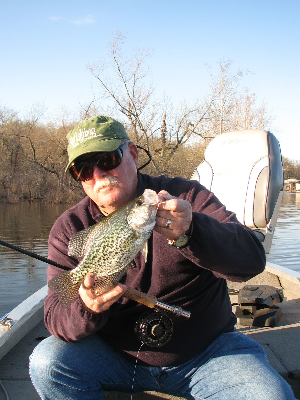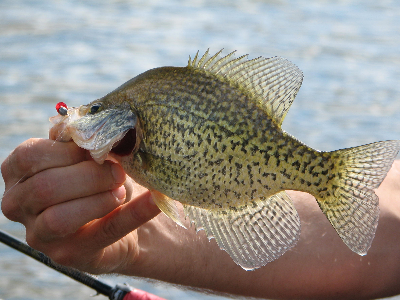It was the biggest crappie I had ever seen, a silvery, black-spotted slab my cousin Brad pulled out of a freeway lake near Kalama, Washington. That was almost 30 years ago. I still haven’t laid eyes on a better one.
Brad caught that timber crappie the way a lot of people do, on a crawler under a cork. In my quest to get a better one, I have found that one of the best ways is with a fly rod in hand.
The reason why is that the crappie as a collective are a fish with a big appetite for smaller food groups. From plankton and aquatic insects up to young-of-the-year minnows and crustaceans, this is a voracious feeder that preys on anything it can wrap its lips around.
The run-of-the-mill speckled crappie that the average angler puts in the bucket runs about a half-pound in size, but they get bigger. It is hard to imagine, but the world record for black crappie tipped the scales at six pounds. Oregon’s state record was pulled out of Gerber Reservoir, a fish that weighed in at an impressive four pounds, six ounces.

Don’t be fooled, a two-pound crappie can slash through a school of six-inch bass with the ferocity of a lion in a pen of goats.
And crappie fight bigger than other fish their size. With a strong tail and a flat body, capable of quick, sharp turns, even a half-pounder can put on a battle against a four-weight rod. When the angler finds one, he finds a school, of 10 or 20 or a hundred or a thousand.
The trick is finding them. Most of the year, crappie hang out in the brush and in the rocks or any submerged structure where they find shelter and lay in wait for bait to ambush.
There are times when they school in deep water, especially when focused on a food source. Crappie are horizontal schoolers, which means instead of stacking in the water column, they are more likely to spread out over a large area. If they find comfortable conditions and a food source 12 feet down, you’re not going to catch a lot of fish at eight feet.
Fly-fishermen in Oregon tend to ignore crappie, but there is a lot to learn and a lot to like about a fishery that can sustain no-limits pressure and turn out catches of 50, 100 and more in a single day.
Frank Amato Publications has published a new book to change that. Crappie Fly-Fishing, by Terry and Roxanne Wilson, takes a seasonal approach to the subject.
My favorite crappie patterns resemble silver-sided minnows. The Wilsons point out that chartreuse is the best accent color to add to the fly. Plain chartreuse is effective, but blended with white, yellow or black, it can be even better. They also recommend blue and pink patterns. Keep changing colors if the catching is slow.
I like a lot of weight on the hook to get the fly down fast and if one fly is good, two are better. Crappie are nothing if not competitive, which means that you can capitalize on their greed by running a small streamer followed by a larger one to simulate a baitfish chasing a baitfish.
 Early spring is transition time and in periods of stable weather, they go on the prowl for groceries. In April and early May, the best fishing is when the sun is on the water in mid-afternoon.
Early spring is transition time and in periods of stable weather, they go on the prowl for groceries. In April and early May, the best fishing is when the sun is on the water in mid-afternoon.
Look for shallow water with a dark bottom where the sun’s warmth is better absorbed. Water that is a couple of degrees warmer than the surrounding lake can attract hungry crappies.
East of the Cascades, some of our best crappie waters are Brownlee Reservoir, Prineville Reservoir, Ochoco Reservoir, Lake Owyhee and Gerber Reservoir. The Columbia can produce some nice crappie.
On the west side, some of the better crappie lakes are Henry Hagg near Forest Grove, Fern Ridge Reservoir and Siltcoos Lake.
Crappie, the Wilsons say, are the Rodney Dangerfield of freshwater fish. They get no respect, especially from fly-fishermen. The Wilsons start their book with a list of 55 names people around the country apply to both black and white crappie. We call them calico bass, goggle-eye, bridge perch, timber crappie, banklick, specks, chinquapin, papermouth and dozens of other appelations, all that give hints as to their nature.
Crappie are invasive species in most waters in our state. If you catch a few, keep them. Filleted and skinned, crappie are fine eating. Call them what you like. I’m calling them dinner.




Recent Comments